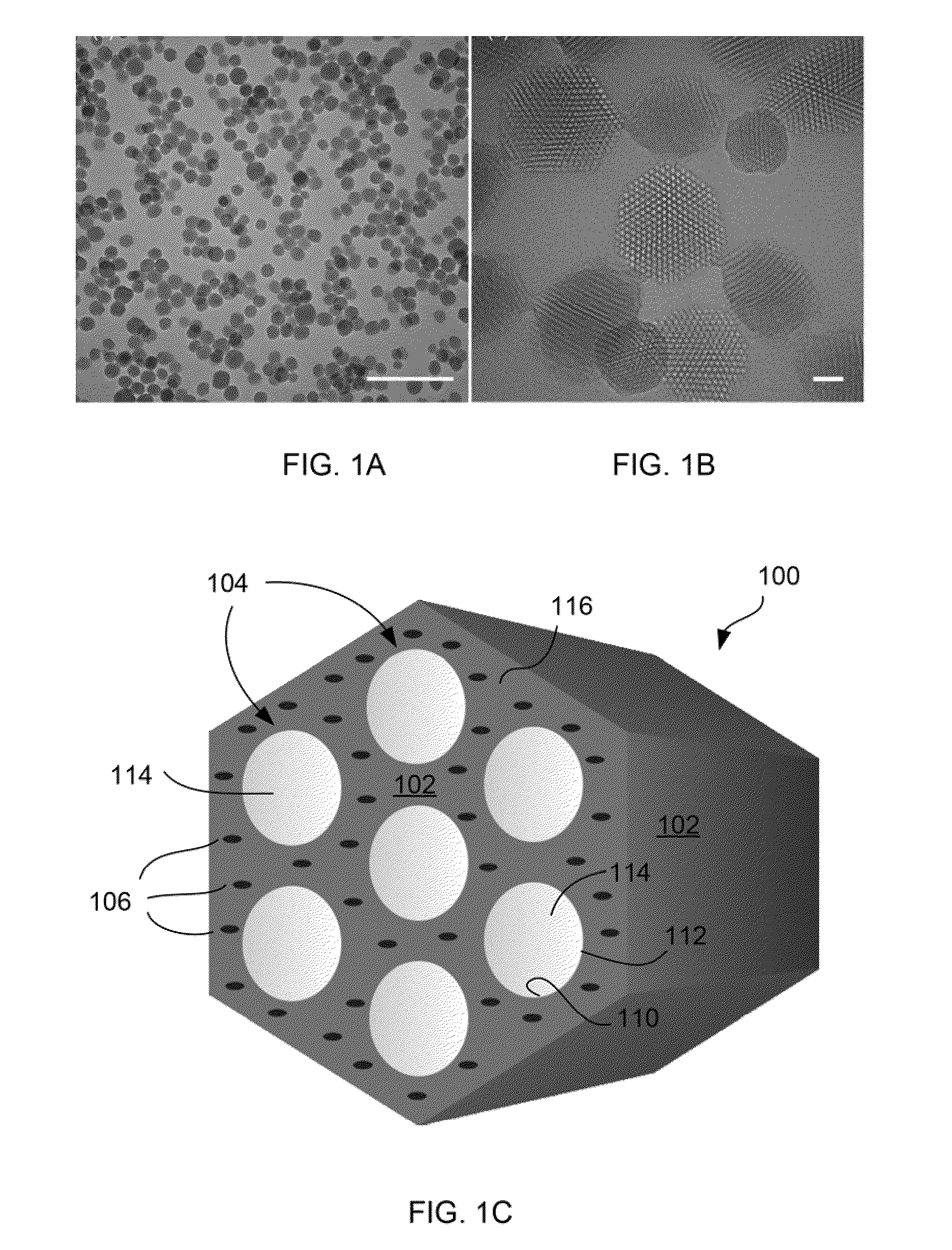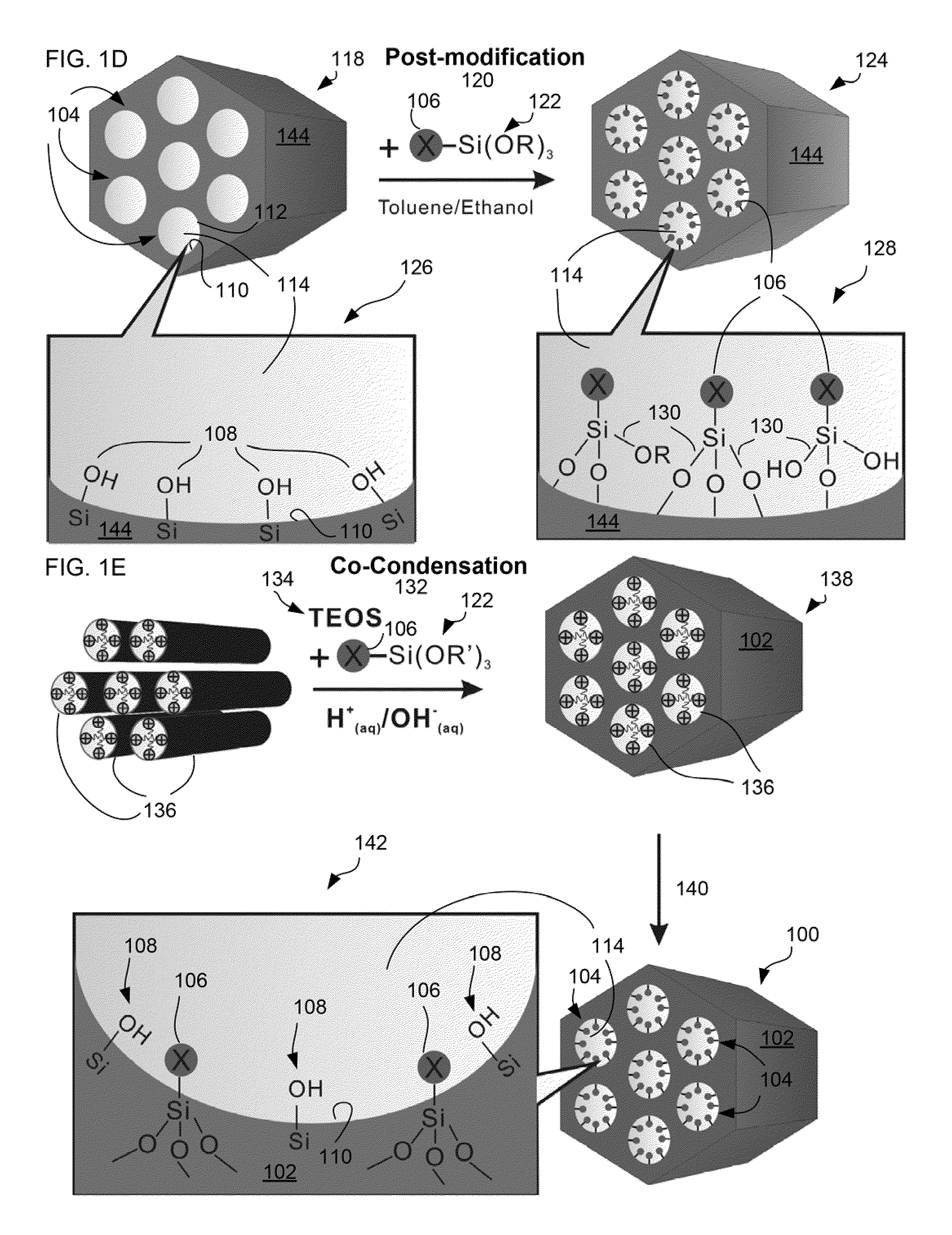Charged mesoporous silica nanoparticle-based drug delivery system for controlled release and enhanced bioavailability
a mesoporous silica nanoparticle and drug delivery technology, applied in the field of controlled release and enhanced bioavailability drug delivery system, can solve the problems of premature release of drug, although successfully passing through the stomach, and difficult to achieve precise control of colon site specific release, so as to enhance the bioavailability of negatively charged drugs
- Summary
- Abstract
- Description
- Claims
- Application Information
AI Technical Summary
Benefits of technology
Problems solved by technology
Method used
Image
Examples
example 1
Preparation of Positive-Charged MSN
[0075]The following materials were purchased from Across: TEOS, CTAB, Orange II and ammonium hydroxide (30%). Sulfasalazine was obtained from Sigma Chemical Co. N-Trimethoxysilylpropyl-N,N,N-trimethylammonium chloride (50% in methanol) was obtained from Gelest. Ringer's solution has a composition very similar to human plasma (NaCl, 8.60 mg; KCl, 0.3 mg; CaCl2, 0.33 mg per mL of H2O).
[0076]MSN-TA Samples were prepared according to the methods as previously described. (Lee et al. (2008) “Synthesis and characterization of positive-charge functionalized mesoporous silica nanoparticles for oral drug delivery of an anti-inflammatory drug” Adv. Funct. Mater. 18:1-10, which is herein incorporated by reference in its entirety). Briefly, various MSN-TA samples with an ordered hexagonal pore structure were synthesized under a low concentration of TEOS, surfactant (CTAB), and a base catalyst (NH4OH) in a two-step preparation. The low concentration of the silic...
example 2
Preparation of Drug-Loaded MSN
[0077]Orange 11-Loaded MSN-TA Samples: Orange II was dissolved in H2O at concentrations of 0.25, 0.75, 1.25, 1.75, 2.25 and 2.75 mM, and the pH was adjusted to 6.8 with NaOH or HCl solution. About 15 mg of MSN-TA sample was added to 2.5 mL of Orange 11 solution and stirred for 2 h at 30° C. The particles were washed with deionized water and centrifuged for 20 min at 12 000 rpm. The supernatant was diluted 50 times with deionized water and analyzed with a UV-Vis spectrometer. The amount of Orange II adsorbed onto nanoparticles was determined by measuring the decrease in the absorption at 480 nm. Calibration experiments were performed separately before each measurement of Orange 11 at different concentrations. The loading percentage of Orange 11 onto MSN-TA-4 was about 5.9% w / w.
[0078]Sulfasalazine-Loaded MSN-TA Samples: A saturated aqueous sulfasalazine solution was prepared by dissolving 0.5 g of sulfasalazine in 1 L of H2O, stirred for 6 h, and filtered...
example 3
[0082]Characteristics of Positive-Charged MSN
TEM
[0083]FIGS. 1A-1B show TEM micrographs of the TA groups-functionalized MSNs (i.e., MSN-TA). The nanochannels were hexagonal in arrangement (FIG. 1B). The MSN-TA samples have a uniform size, with an average particle diameter of about 100 nm (FIGS. 1A-1B). Conjugation of TA functional groups onto the MSN samples did not appear to affect the MSN's size (data not shown). These results indicated that the different density of the organic functional groups in MSN can be easily controlled and optimized by the sol-gel co-condensation process.
Powder XRD
[0084]FIG. 2 shows the X-ray diffraction (XRD) patterns of the MSN-TA samples: (a) MSN-TA-1, (b) MSN-TA-2, (c) MSN-TA-3, and (d) MSN-TA-4. All the samples exhibit a hexagonal mesoporous structure, which is typical of MCM-41 type with (100), (110), and (200) reflections of P6 mm symmetry. As the amounts of the TA groups in the MSN-TA increased, the XRD patterns showed gradual broadening, indicating...
PUM
| Property | Measurement | Unit |
|---|---|---|
| Bioavailability | aaaaa | aaaaa |
| Isoelectric point | aaaaa | aaaaa |
Abstract
Description
Claims
Application Information
 Login to View More
Login to View More - R&D
- Intellectual Property
- Life Sciences
- Materials
- Tech Scout
- Unparalleled Data Quality
- Higher Quality Content
- 60% Fewer Hallucinations
Browse by: Latest US Patents, China's latest patents, Technical Efficacy Thesaurus, Application Domain, Technology Topic, Popular Technical Reports.
© 2025 PatSnap. All rights reserved.Legal|Privacy policy|Modern Slavery Act Transparency Statement|Sitemap|About US| Contact US: help@patsnap.com



